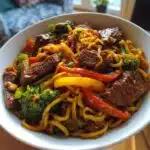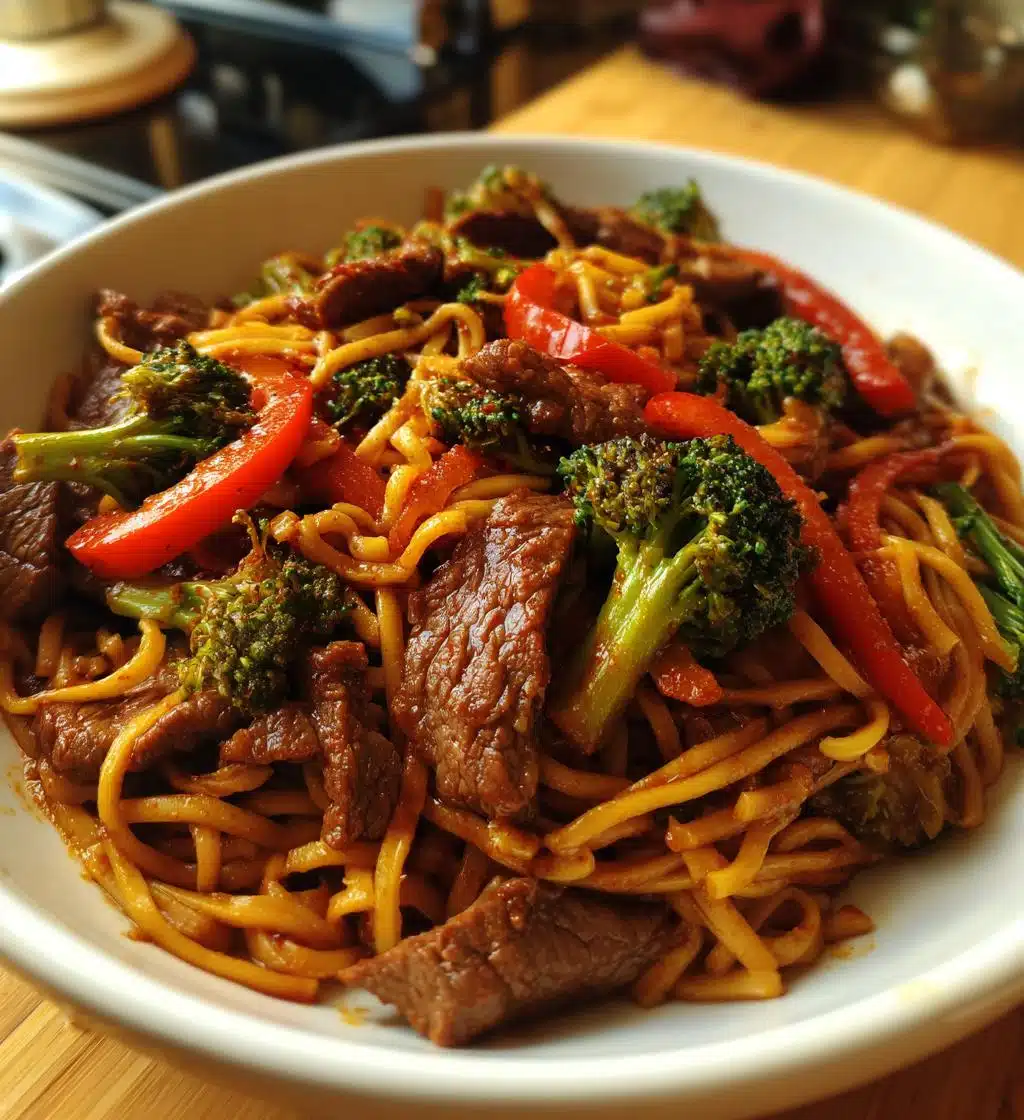Oh my goodness, let me tell you about my absolute favorite comfort food: spicy Korean gochujang beef noodles! This dish is a whirlwind of flavors that just dances on your taste buds. The heat from the gochujang paired with tender beef and fresh veggies creates a symphony of taste that’s simply irresistible. I first stumbled upon this beauty while dining at a cozy Korean restaurant, and I was immediately hooked. It’s become a staple in my kitchen ever since! Not only is it packed with bold flavors, but it’s also super quick to whip up. Trust me, once you try it, you’ll want to make it a weekly ritual! The best part? It’s beloved in Korean cuisine for its vibrant taste and satisfying texture, and now you can enjoy it right at home!
Ingredients List
Gather these simple yet essential ingredients to create your spicy Korean gochujang beef noodles. Having everything prepped and ready makes the cooking process so much smoother!
- 8 oz noodles (any type you prefer, but I love using rice noodles or udon for that perfect chew)
- 1 lb beef, sliced thinly against the grain (this ensures it stays tender and juicy)
- 2 tbsp gochujang (this spicy Korean chili paste is the star of the show!)
- 2 tbsp soy sauce (adds depth and umami—don’t skip it!)
- 1 tbsp sesame oil (for that nutty aroma that brings everything together)
- 2 cloves garlic, minced (because garlic makes everything better, right?)
- 1 tsp ginger, minced (adds a lovely zing to the dish)
- 1 cup bell peppers, sliced (I like a mix of colors for a vibrant dish)
- 1 cup broccoli florets (for some crunch and nutrition)
- 2 green onions, chopped (they make for a fresh, zesty garnish)
Once you have all these goodies, you’re just a few steps away from flavor town!
How to Prepare Instructions
Alright, let’s dive into making these mouthwatering spicy Korean gochujang beef noodles! Follow these steps, and you’ll be savoring this dish in no time.
- First, cook the noodles according to the package instructions. You want them al dente, so keep an eye on the clock!
- While the noodles are cooking, grab a bowl and mix together the gochujang, soy sauce, and sesame oil. This will be your delicious sauce that brings everything together.
- Next, heat a pan over medium-high heat and add the sliced beef. Cook it until it’s nicely browned, which should take about 5 minutes. The smell will be amazing!
- Once the beef is browned, toss in the minced garlic and ginger, sautéing for about a minute until fragrant. Wow, your kitchen is going to smell incredible!
- Now, add the sliced bell peppers and broccoli florets to the pan. Stir-fry them until they’re tender, which should take around 3-4 minutes.
- Pour your prepared sauce over the beef and veggies, stirring to combine everything deliciously.
- Finally, add your cooked noodles to the pan and gently toss everything together to coat those noodles in that spicy goodness.
- Just before serving, garnish with chopped green onions for that perfect finishing touch!
And there you have it—a vibrant, spicy dish that’s ready to impress!
Why You’ll Love This Recipe
- Incredibly flavorful with the perfect balance of heat and umami from the gochujang sauce.
- Quick and easy to prepare—ready in just 30 minutes!
- Packed with protein and veggies, making it a nutritious dinner option.
- Customizable! You can add your favorite vegetables or adjust the spice level to suit your taste.
- Perfect for busy weeknights or impressing guests with minimal effort.
Tips for Success
To make your spicy Korean gochujang beef noodles truly shine, here are some of my top tips! First, don’t be shy with the gochujang; if you love heat, feel free to add more. You can also mix in a splash of rice vinegar for a hint of tang that elevates the flavors. When it comes to cooking the beef, make sure your pan is hot enough before adding it—this helps achieve that beautiful sear and keeps it juicy.
Also, consider adding other veggies like snap peas or carrots for extra color and crunch! Serve your noodles with a sprinkle of sesame seeds or a drizzle of extra sesame oil for an added layer of flavor. And trust me, these noodles taste even better the next day, so don’t hesitate to make a double batch!
Variations
If you’re feeling adventurous or just want to mix things up, there are plenty of ways to customize your spicy Korean gochujang beef noodles! Swap out the beef for chicken, shrimp, or even tofu for a vegetarian option—each protein brings its own unique flavor to the dish. You can also play with the vegetables; try adding zucchini, snap peas, or carrots for a different texture and taste.
Feeling extra spicy? Toss in some sliced jalapeños or a sprinkle of chili flakes for an added kick. And don’t forget about fresh herbs like cilantro or basil to brighten things up. The possibilities are endless, so get creative and make it your own!
Storage & Reheating Instructions
If you find yourself with leftovers (which is always a win!), storing your spicy Korean gochujang beef noodles is super simple. Just let them cool to room temperature, then transfer them into an airtight container. They’ll stay fresh in the fridge for up to 3 days. If you want to keep them longer, you can freeze them for up to a month. Just make sure to separate the noodles from the veggies if you can, as they might get a bit mushy when thawed.
When it’s time to enjoy those leftovers, simply reheat them in a pan over medium heat, adding a splash of water or broth to keep things moist. Stir until heated through, and voilà—dinner is served again!
Nutritional Information Section
It’s important to note that the nutritional values for my spicy Korean gochujang beef noodles can vary based on the specific ingredients and brands you use. While I’ve provided a general breakdown per serving, keep in mind that these numbers are estimates and may not be precise. Always feel free to adjust the recipe to fit your dietary needs and preferences!
FAQ Section
Can I make this recipe ahead of time?
Absolutely! You can prepare the beef and sauce in advance and store them in the fridge. Just cook the noodles fresh when you’re ready to serve!
What can I use instead of gochujang?
If you can’t find gochujang, you can substitute it with Sriracha mixed with a bit of miso for that spicy depth. It won’t be quite the same, but it’ll still be tasty!
Is this recipe gluten-free?
Yes, as long as you use gluten-free noodles and soy sauce, this spicy Korean gochujang beef noodles recipe is gluten-free!
Can I add more vegetables?
Definitely! Feel free to toss in any veggies you love—things like bok choy, mushrooms, or even spinach work beautifully!
For more delicious recipes, check out our blog for inspiration!
Learn more about gochujang and its uses in Korean cuisine!
Print
Spicy Korean Gochujang Beef Noodles Recipe for Bold Flavors
- Total Time: 30 minutes
- Yield: 4 servings 1x
- Diet: Gluten Free
Description
Spicy Korean gochujang beef noodles are a flavorful dish that combines tender beef with spicy gochujang sauce and noodles.
Ingredients
- 8 oz noodles
- 1 lb beef, sliced
- 2 tbsp gochujang
- 2 tbsp soy sauce
- 1 tbsp sesame oil
- 2 cloves garlic, minced
- 1 tsp ginger, minced
- 1 cup bell peppers, sliced
- 1 cup broccoli florets
- 2 green onions, chopped
Instructions
- Cook the noodles according to package instructions.
- In a bowl, mix gochujang, soy sauce, and sesame oil.
- Heat a pan over medium-high heat and add the beef.
- Cook the beef until browned, about 5 minutes.
- Add garlic and ginger; sauté for 1 minute.
- Add bell peppers and broccoli; cook until tender.
- Pour the sauce over the beef and vegetables; stir to combine.
- Add cooked noodles and toss to coat.
- Garnish with green onions before serving.
Notes
- Adjust spice level by adding more or less gochujang.
- Serve with extra vegetables if desired.
- Prep Time: 15 minutes
- Cook Time: 15 minutes
- Category: Dinner
- Method: Stir-fry
- Cuisine: Korean
Nutrition
- Serving Size: 1 serving
- Calories: 500
- Sugar: 5g
- Sodium: 800mg
- Fat: 20g
- Saturated Fat: 5g
- Unsaturated Fat: 15g
- Trans Fat: 0g
- Carbohydrates: 60g
- Fiber: 5g
- Protein: 30g
- Cholesterol: 70mg
Keywords: spicy korean gochujang beef noodles recipe


